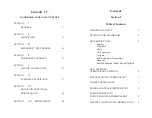
SECTION 3
CESSNA
EMERGENCY PROCEDURES
MODEL 172RG
LANDING WITH A FLAT MAIN TIRE
1.
Approach -- NORMAL (full flap).
2.
Touchdown -- GOOD TIRE FIRST, hold airplane off flat tire as long
as possible with aileron control.
3.
Directional Control -- MAINTAIN using brake on good wheel as
required.
ELECTRICAL POWER SUPPLY SYSTEM
MALFUNCTIONS
AMMETER SHOWS EXCESSIVE RATE OF CHARGE
(Full Scale Deflection)
1.
Alternator -- OFF.
2.
Alternator Circuit Breaker -- PULL.
3.
Nonessential Electrical Equipment -- OFF.
4.
Flight -- TERMINATE as soon as practical.
LOW-VOLTAGE LIGHT ILLUMINATES DURING FLIGHT
( Ammeter Indicates Discharge
NOTE
Illumination of the low-voltage light may occur during
low RPM conditions with an electrical load on the system
such as during a low RPM taxi. Under these conditions, the
light will go out at higher RPM. The master switch need not
be recycled since an over-voltage condition has not
occurred to de-activate the alternator system.
1.
Avionics Power Switch -- OFF.
2.
Alternator Circuit Breaker -- CHECK IN.
3.
Master Switch -- OFF (both sides).
4.
Master Switch -- ON.
5.
Low-Voltage Light -- CHECK OFF.
6.
Avionics Power Switch -- ON.
If low-voltage light illuminates again:
7.
Alternator -- OFF.
8.
Nonessential Radio and Electrical Equipment -- OFF.
9.
Flight -- TERMINATE as soon as practical.
3-10
1 July 1979
CESSNA
SECTION 3
MODEL 172RG
EMERGENCY PROCEDURES
AMPLIFIED PROCEDURES
ENGINE FAILURE
If an engine failure occurs during the takeoff run, the most important
thing to do is stop the airplane on the remaining runway. Those extra items
on the checklist will provide added safety after a failure of this type.
Prompt lowering of the nose to maintain airspeed and establish a glide
attitude is the first response to an engine failure after takeoff. In most
cases, the landing should be planned straight ahead with only small
changes in direction to avoid obstructions. Altitude and airspeed are
seldom sufficient to execute a 180° gliding turn necessary to return to the
runway. The checklist procedures assume that adequate time exists to
secure the fuel and ignition systems prior to touchdown.
After an engine failure in flight, the best glide speed as shown in figure
3-1 should be established as quickly as possible. While gliding toward a
suitable landing area, an effort should be made to identify the cause of the
failure. If time permits, an engine restart should be attempted as shown in
the checklist. If the engine cannot be restarted, a forced landing without
power must be completed.
Figure 3-1. Maximum Glide
1 July 1979
3-11
















































